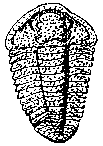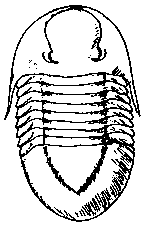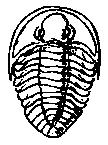
Trilobites are extinct members of the Arthropod family which were quite common in the Paleozoic sea waters that covered what is now the area in and around Cincinnati, Ohio. Fossils of these creatures, although plentiful, are sometimes hard to find. But persistent looking can lead to great "treasures" and, once in a while, pockets of these long-gone creatures.
Although only a couple of species are very common in the area, about 18 species of trilobites have been found in the limestones and shales of the region. This home page is designed to acquaint you with some of the more common, and a few of the less common, members of the trilobite family of the Ordovician Period of Cincinnati history.

Achatella carleyi: a rare trilobite. The exoskeleton is somewhat flattened with very prominent compound eyes. Usually found in the Fairview Formation.

Acidaspis cincinnatiensis: a spiny trilobite. Rarely found complete, pieces can be found in many rocks from the Kope up into the Maysville. Cephalon contains a characteristic occipital spine extending over the thorax. Generally of very small size, but some specimens measuring several centimeters have been found. Click here for a photo of Acidaspis

Allolichas shideleri: although cephalons and pygidiums have
been found, less than half a dozen complete specimens have been collected.
Characterized by a beautiful pygidium (or tail).
Identification of Allolichas Fragments
Click here for more photographs of Allolichas

Ceraurinus icarus: very rare. Even pieces of this trilobite are
difficult to find. Located in the Liberty and Whitewater Formations.
Identification
of Ceraurinus Fragments
Click here for
photographs of Ceraurinus.

Ceraurus milleranus: complete specimens are rare, but parts can
be found, abundantly in some locations. Characterized by a pair of curved spines
on the pygidium. Known from the Fairview Formation. Identification
of Ceraurus Fragments
Click Here for Photos of Ceraurus

Tricopelta breviceps (formerly Chasmops
breviceps): similar in some respects to Phacops of the Devonian, this
trilobite was once thought to be found only in the Whitewater Formation. It has
now been found in the Liberty Formation.
Click here for photos of Tricopelta Trilobites from Dan Cooper

Cryptolithus bellulus: the "laced-collar" trilobite of the Kope Formation. Cephalons and parts of cephalons are readily found. However, complete skeletons are difficult to find because the thoracic segments are very thin and fragile. Identification of Cryptolithus fragments

Flexicalymene meeki: the most common trilobite of the Cincinnatian. Pieces, as well as complete specimens, can be found in nearly all rock formations above the Kope. Other species include F. retrorsa, not pictured.
Click here to see pictures of Flexicalymene
Fragments
Click here to see pictures of whole Flexicalymenes
Click here for photos of Flexi's found on field trips

Flexicalymene granulosa: a smaller version of F. meeki, found in the Kope. The skeleton is covered with little bumps. Hence, the species name.

Isotelus maximus: the largest trilobite of the area. Complete specimens up to 40 cm. in length have been found. Pieces collected indicate that some grew to as much as 60 cm. (24 inches) or more. This is the official Ohio state fossil.
Click here to see pictures of Isotelus Fragments
Click here for photos of Isotelus trilobites found on field trips

Meadowtownella crosotus (suspected by some to be Meadowtownella crosotus): another small, rare trilobite, similar to Acidaspis, but without the occipital spine. Pieces are found in some rocks. Limited to the lower portions of the Kope Formation.
Click here for photos of Meadowtownella crosotus

Proetus spurlocki: very rare. Fragments are not common. Only known specimens are not very complete because of the fragile nature of the exoskeleton.

Triarthrus eatoni: generally limited to the base of the Kope Formation. Although complete specimens have been found, they are extremely rare.
Written by Rich Fuchs, Dry Dredgers Vice President.
More information on Trilobites
Back to Dry Dredgers Home Page
Cincinnati Trilobite Fragment Identifier
Other Cincinnati Fossils by Rich Fuchs
The Dry Dredgers and individual contributors
reserve the rights to all information, images, and content presented here.
Permission to reproduce in any fashion, must be requested in writing to admin@drydredgers.org
.
www.drydredgers.org is designed and
maintained by Bill Heimbrock.